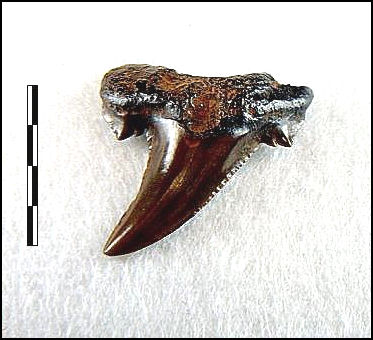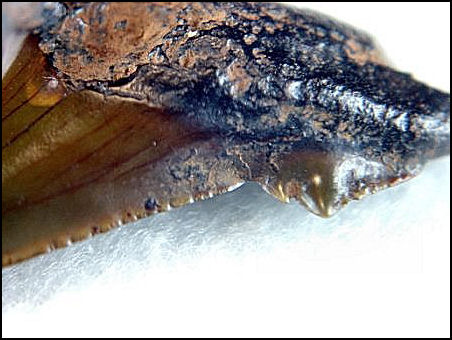|
Rics and Chubs
Carcharocles sp. ( Jordan &
Hannibal )
Age - Tertiary Commonality - Uncommon
At present there is a great deal of confusion as to the number of
species in this group. Elasmo.com includes six broadly-defined
chronospecies:
C. aksuaticus (MENNER) late Early Eocene
C. auriculatus (BALINVILLE) early Middle Eocene
C. sokolovi (JAEKEL) late Middle Eocene to Early Oligocene
C. angustidens (AGASSIZ) Early Oligocene
C. chubutensis AMEGHINO) Late Oligocene
C. megalodon (AGASSIZ) Miocene-Pliocene
Generally speaking the Carcharocles teeth found in Monmouth
County, NJ are assigned to one of two species, C. auriculatus (Rics)
or
C. chubutensis (Chubs). I personally believe that some of these
teeth may represent some of the additional species mentioned above. But for now, will limit this
page to C. auriculatus and C. chubutensis. Of the two
Monmouth County species C. auriculatus is the oldest, first
appearing in the middle Eocene, the teeth of C. auriculatus have
large, coarsely serrate cusplets. The serrations on the main cusp when
not worn by stream action are very irregular. C. chubutensis
is an early to middle Miocene species with smaller more uniformed
cusplets, a broader crown and more regular serrations on the blade.
Complete teeth of both species are difficult to come by.

Lateral C. auriculatus
Scale 1 inch
Monmouth County, NJ

Close up of the coarsely serrate cusplets and irregular serrations.

Anterior C. auriculatus, the serrations on this tooth are coarse
and
extend almost
completely to the tip of the crown.

C. chubutensis shows a broad crown, regular serrations and
diminished cusplets
Specimen from Virginia
2 1/4 inches

Cusp of C. chubutensis
Return to top of page
|
